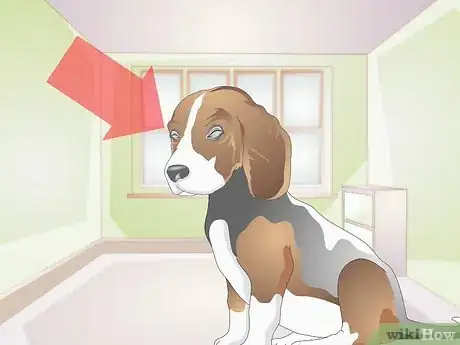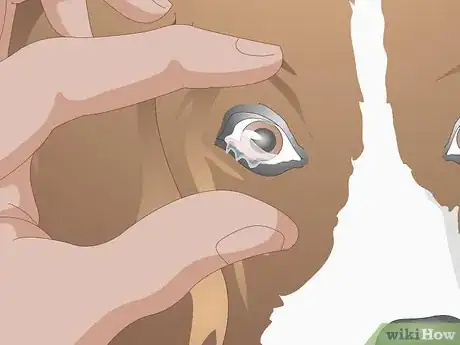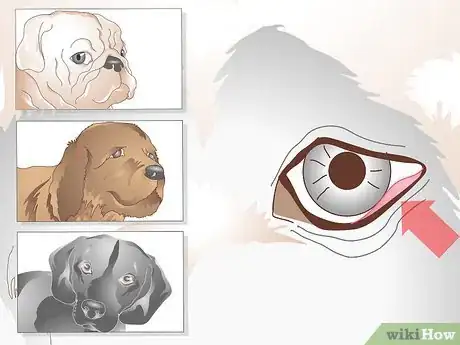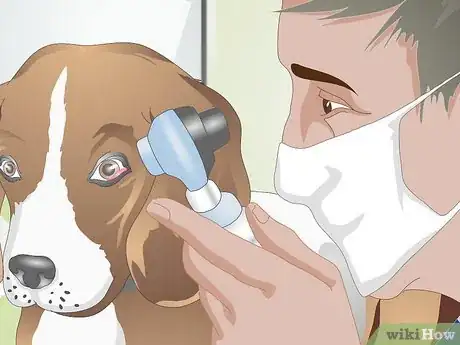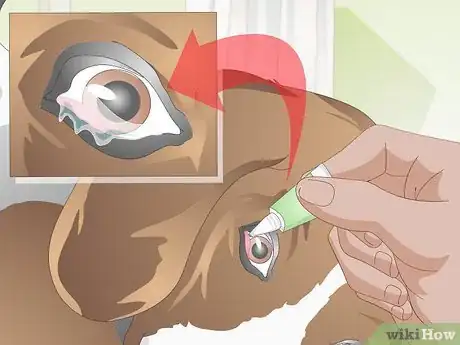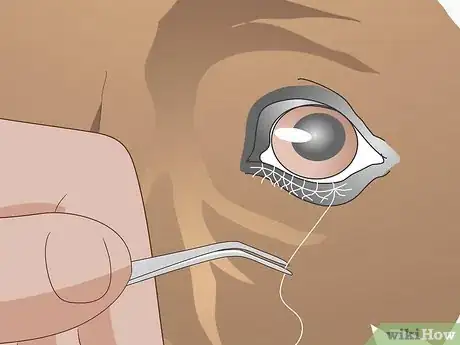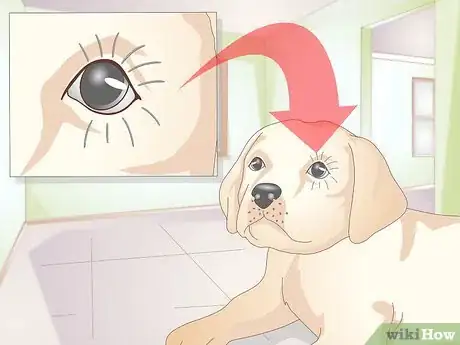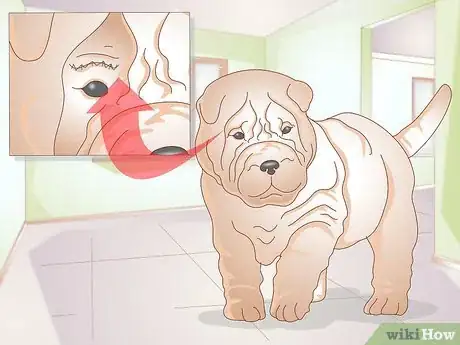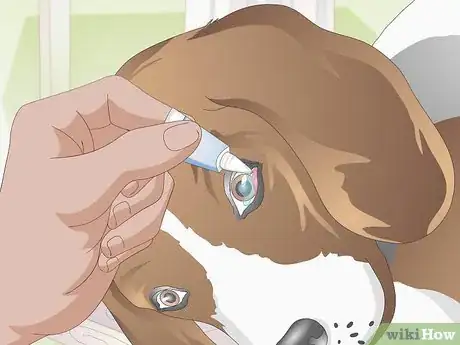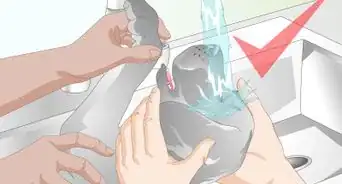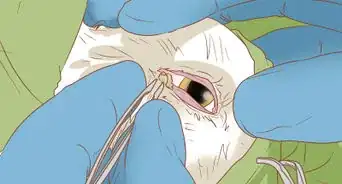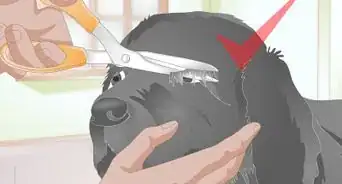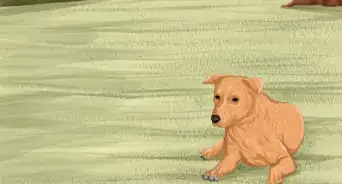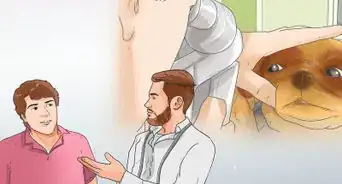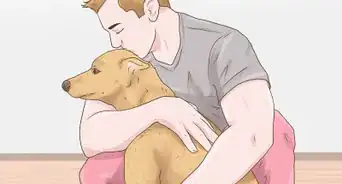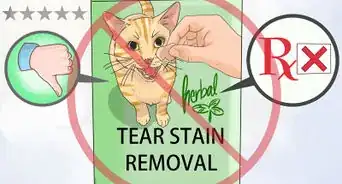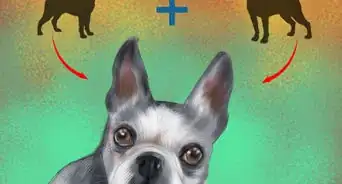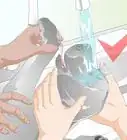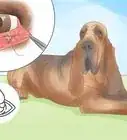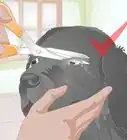This article was co-authored by Pippa Elliott, MRCVS and by wikiHow staff writer, Jessica Gibson. Dr. Elliott, BVMS, MRCVS is a veterinarian with over 30 years of experience in veterinary surgery and companion animal practice. She graduated from the University of Glasgow in 1987 with a degree in veterinary medicine and surgery. She has worked at the same animal clinic in her hometown for over 20 years.
This article has been viewed 25,595 times.
Dogs can suffer from a variety of eye problems. Ingrown eyelids (also known as entropion) are one of the more uncomfortable conditions that may affect your dog's vision. With an ingrown eyelash, your dog's eyelid rolls inward so that the eyelashes press against the cornea of the eye instead of out. This can cause constant irritation and discomfort. Continued rubbing against the eye may lead to corneal ulcers. Get your dog diagnosed with entropion so that the eyelids can be surgically corrected.
Steps
Recognizing and Diagnosing Ingrown Eyelids
-
1Look for squinting. Squinting is an easily recognized sign of eye irritation. Your dog may squint if it feels like there's something in the eye that it can't get out. In this case, the ingrown eyelid is causing the eyelashes to rub directly against the eye. If you can't tell if your dog is squinting, compare the size of your dog's irritated eye to the other one. If they're not the same size, your dog is squinting one.
- Your dog may just keep the eye closed because it's so uncomfortable.
-
2Watch for watery eyes. You may not be able to tell if an ingrown eyelid is irritating your dog's eyes just by looking at the eyes. But you'll probably see your dog's eyes watering excessively if an ingrown eyelid is causing an eyelash to rub against the eye. The dog may blink more to empty the eyes of tears. Larger dogs may also have pus around the outer corners of the eyes.[1]
- You may also notice tear staining down your dog's cheeks. This suggests your dog's eyes are constantly irritated.
Advertisement -
3Look for your dog rubbing an eye. Your dog may rub at its eye with a paw. Since this may give your dog minor relief, your dog may continually swipe its eye with its paws so you'll need to monitor your dog for eye infection. If your dog develops an eye infection, you'll see yellow-green discharge.[2]
- Instead of swiping its eye with a paw, your dog may rub its face along the ground.
-
4Consider your dog's risk. Dogs that are known for wrinkly faces (like Pekinese, Basset hounds, and pugs) are commonly associated with ingrown eyelids caused by entropion. This is because the weight of the extra skin pushes down on the eyelids which causes them to roll into the eye. Entropion can also occur in any breed. Entropion is often found in:[3]
- Bulldogs
- Shih Tzus
- Boxers
- Cocker and springer spaniels
- Dalmatians
- Labradors
- Golden retrievers
-
5Get your dog examined. If you notice any symptoms of eye irritation, take your dog to the vet. The vet will examine your dog's eyes under magnification to see how well the eyelid sits against the cornea. The vet will also check to see if any hairs are rubbing against the surface of the eye.[4]
- It's better to take your dog in if you suspect any eye irritation than to wait. When eye conditions like entropion are left untreated, your dog can develop secondary eye problems.
-
6Check for secondary eye problems. To rule out secondary eye problems (like a corneal ulcer), the vet will put a special dye into the eye. The vet will also check eye pressure and measure your dog's tear production. These will all alert the vet as to whether or not there are additional eye conditions that need to be treated before treating the ingrown eyelid.
- These tests are not painful, but the vet may give your dog topical anesthetic drops to keep your dog relaxed and comfortable.
Surgically Treating Ingrown Eyelids
-
1Get blepharoplasty surgery. The common treatment for ingrown eyelids is a procedure that removes a sliver of skin from immediately below or above the eyelid. This blepharoplasty treatment should make the eyelid lie flush against the cornea instead of turn in towards it.
- Some surgeons may recommend doing two small surgeries to remove very small amounts of skin. This prevents the removal of to much skin at once and another surgery can be added if the entropion is still present after the first surgery.
-
2Get eyelid tacking if your dog is young. If you have a puppy with ingrown eyelids, the vet may recommend temporarily tacking your dog's eyelids. This is because young dogs who get blepharoplasty may continue growing, requiring another surgery. Instead, with tacking, your dog will get a brief anesthetic in order to put tacking sutures near the eyelid. These will help turn the eyelids out.
- Once your dog has finished growing, the vet will give another anesthetic and remove the tacking sutures. Then your dog can get a full blepharoplasty.
-
3Consider lifting the your dog's skin folds. For dogs with heavy skin folds such as the Shah Pei, basset hound or bloodhound, a full 'face lift' may be needed. This is because the sheer amount of extra skin falls forward into the eyes every time your dog lowers its head. A surgeon will remove excess skin and pull the facial folds backwards.[5]
- This is a major surgery and is usually only done if blepharoplasty hasn't worked for your dog. Realize that it will significantly change your dog's appearance.
-
4Do follow up treatment for corneal ulcers. During the diagnosing exam, the vet will have checked for corneal ulcers. These are caused by repeated rubbing of an eyelash against the cornea. Most shallow corneal ulcers will heal on their own once the ingrown eyelids are treated. If your dog had deeper corneal ulcers, the vet will probably treat with medicated eye drops and surgery (if there's a lot of damage).[6]
- Your dog may need to be hospitalized for corneal ulcer surgery. Your dog may need up to three weeks for a deep corneal ulcer to heal and will need to keep a patch in place over the eye.
-
5Keep your dog in a cone after surgery. The vet will probably recommend putting your dog in an Elizabethan collar or cone until the eyes have healed, usually about 2 weeks after surgery. If your dog also had corneal ulcer surgery, it may have gotten a drain put in place. Follow your vet's recommendations for cleaning and maintaining the drain.[7] [8]
- Be sure to go to follow up appointments with the vet. This way, the vet can monitor your dog's healing and adjust any medications your dog is taking.
References
- ↑ http://www.petmd.com/dog/conditions/eyes/c_multi_entropion
- ↑ http://www.vcahospitals.com/main/pet-health-information/article/animal-health/eyelid-entropion-in-dogs/1009
- ↑ http://www.vcahospitals.com/main/pet-health-information/article/animal-health/eyelid-entropion-in-dogs/1009
- ↑ http://www.vcahospitals.com/main/pet-health-information/article/animal-health/eyelid-entropion-in-dogs/1009
- ↑ http://veterinarymedicinejournal.usamv.ro/pdf/2013/vol19_3/art21.pdf
- ↑ http://www.2ndchance.info/cornealulcer.htm
- ↑ http://www.petmd.com/dog/conditions/eyes/c_multi_entropion?page=show
- ↑ http://veterinarymedicinejournal.usamv.ro/pdf/2013/vol19_3/art21.pdf
About This Article
To treat an ingrown eyelid in your dog, watch for common symptoms like squinting, watery eyes, eye discharge, or pawing at its eyes. If you’ve noticed symptoms of an ingrown eyelid in your dog, take it to the vet for an eye exam and treatment. In addition to examining your dog's eyes, the vet may put a special dye in its eyes to check for underlying issues like abrasions or glaucoma. If your dog does have an ingrown eyelid, you may need to schedule blepharoplasty surgery, which will remove a sliver of skin from directly below and above the eyelid to help it heal. Or, if your dog is still a puppy, the vet may tack its eyelids temporarily instead to help turn the eyelids out. . To learn how to determine if your dog is at risk for ingrown eyelids, read more from our Veterinary co-author.
